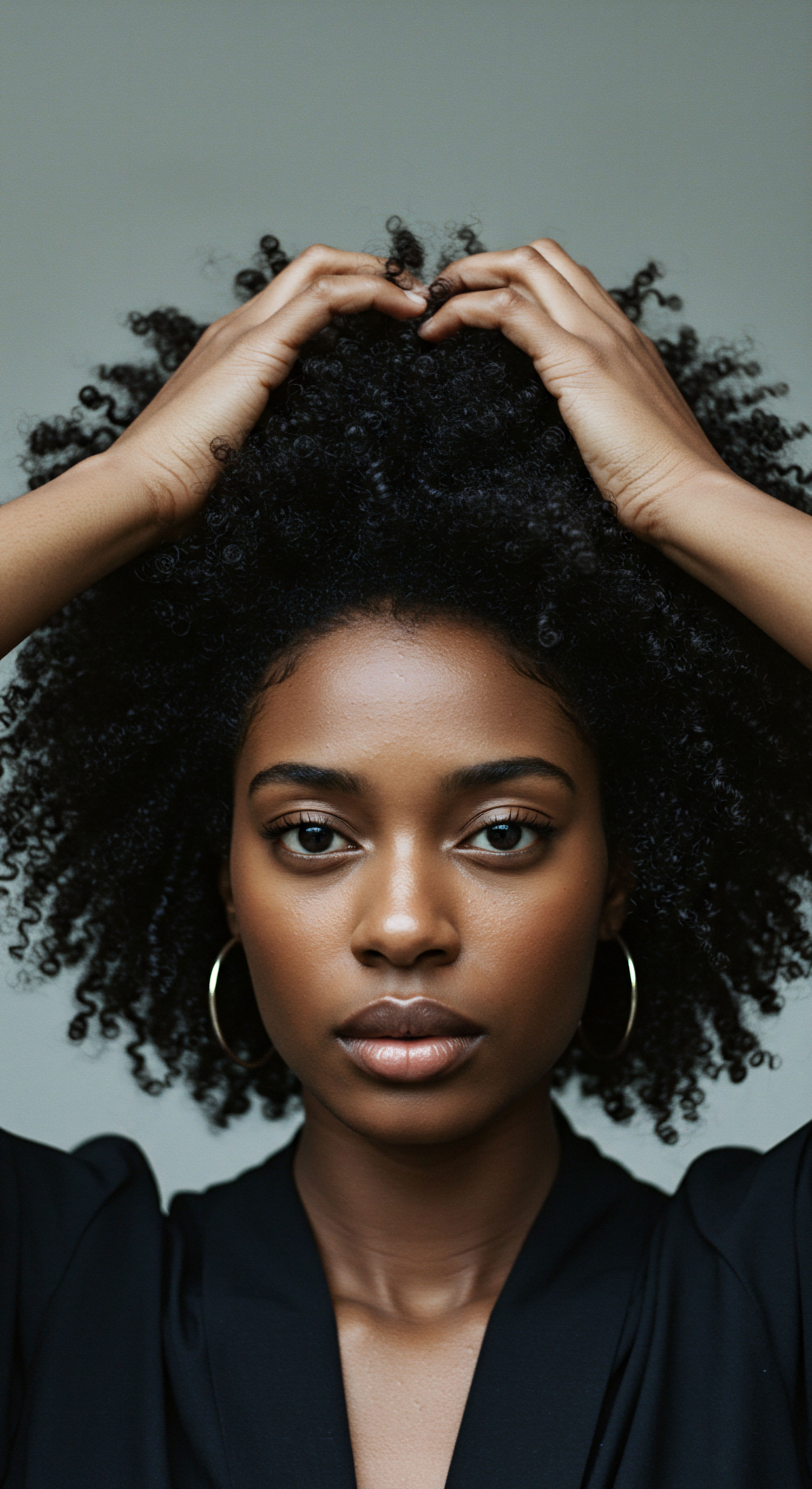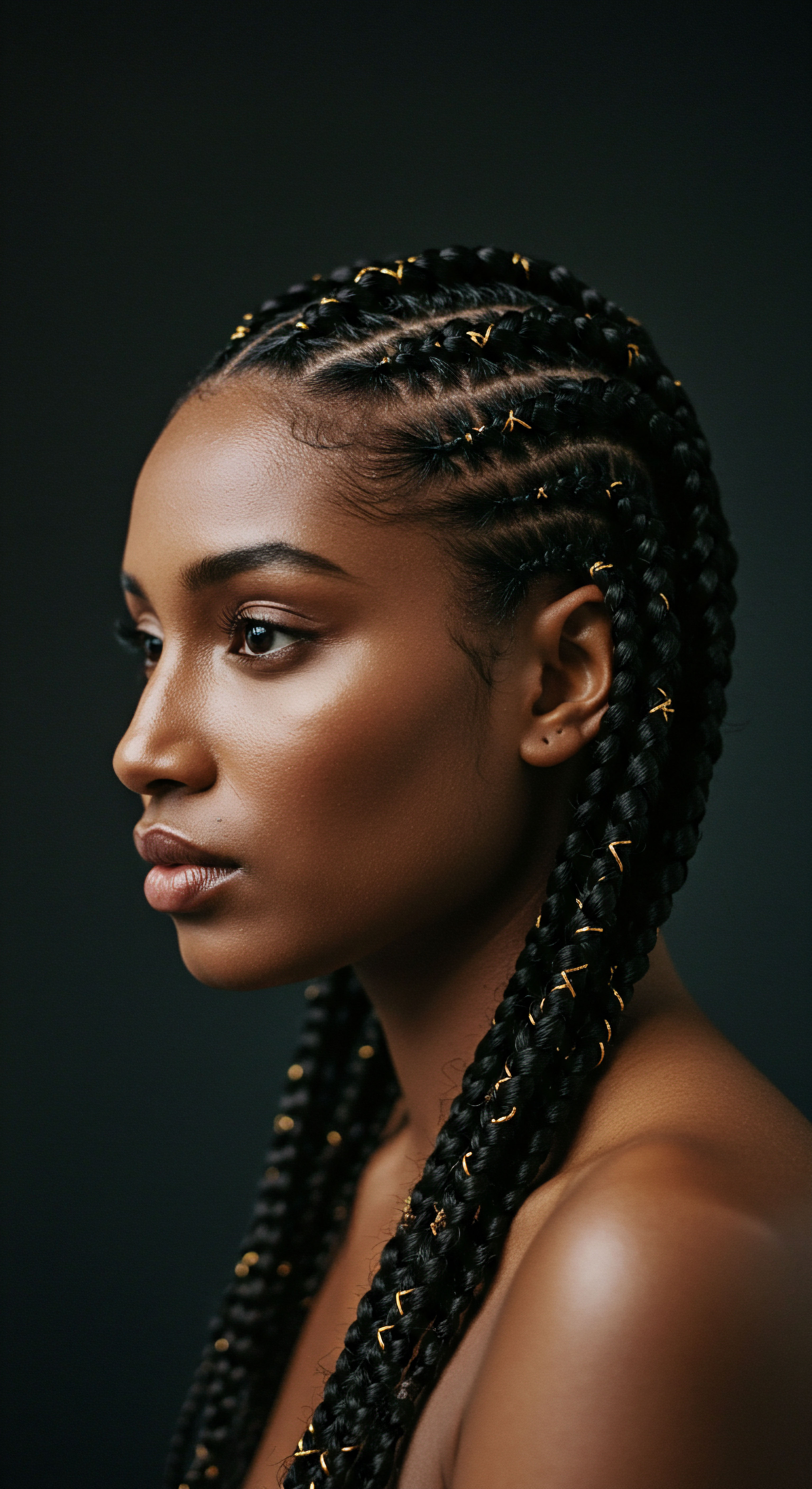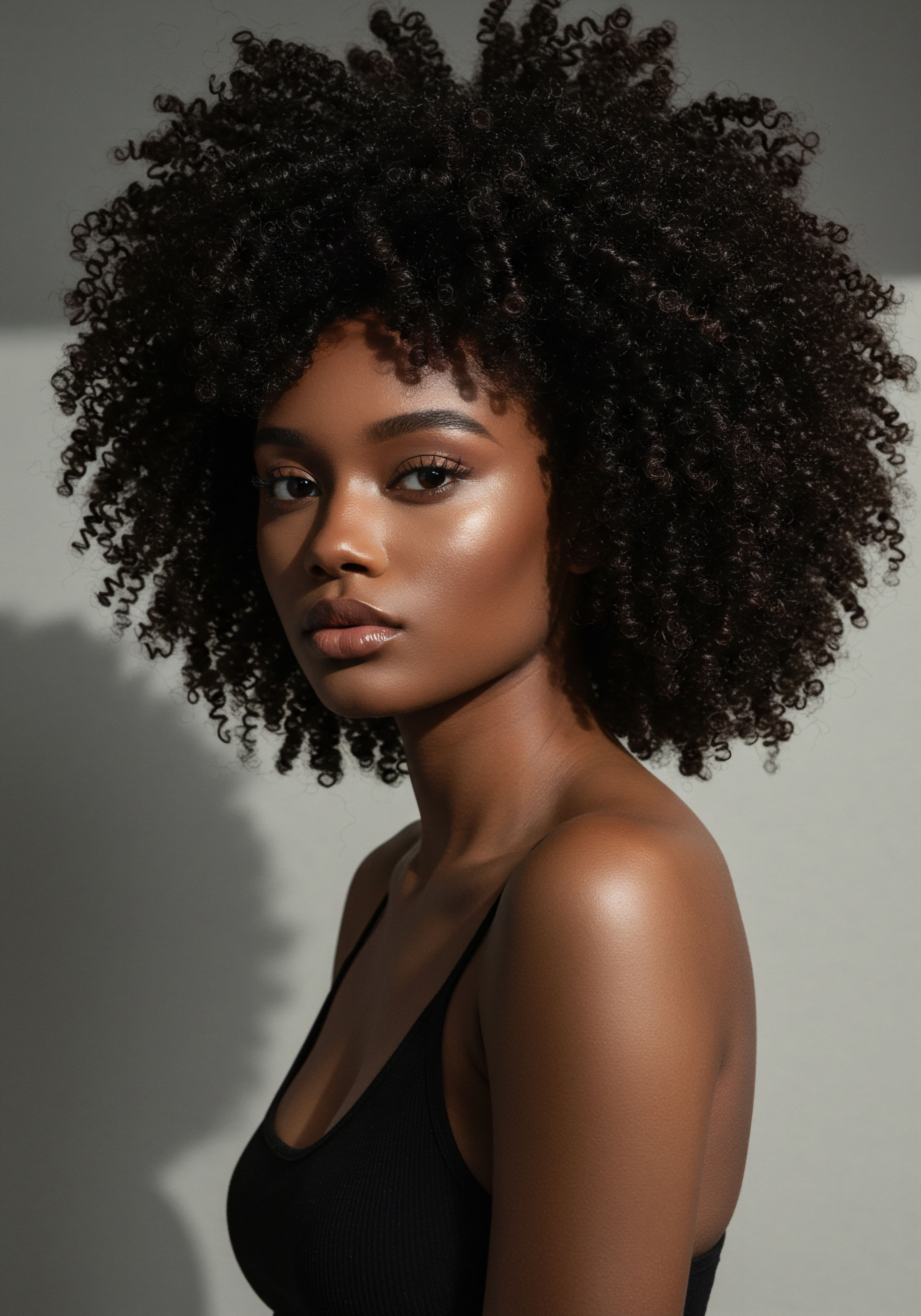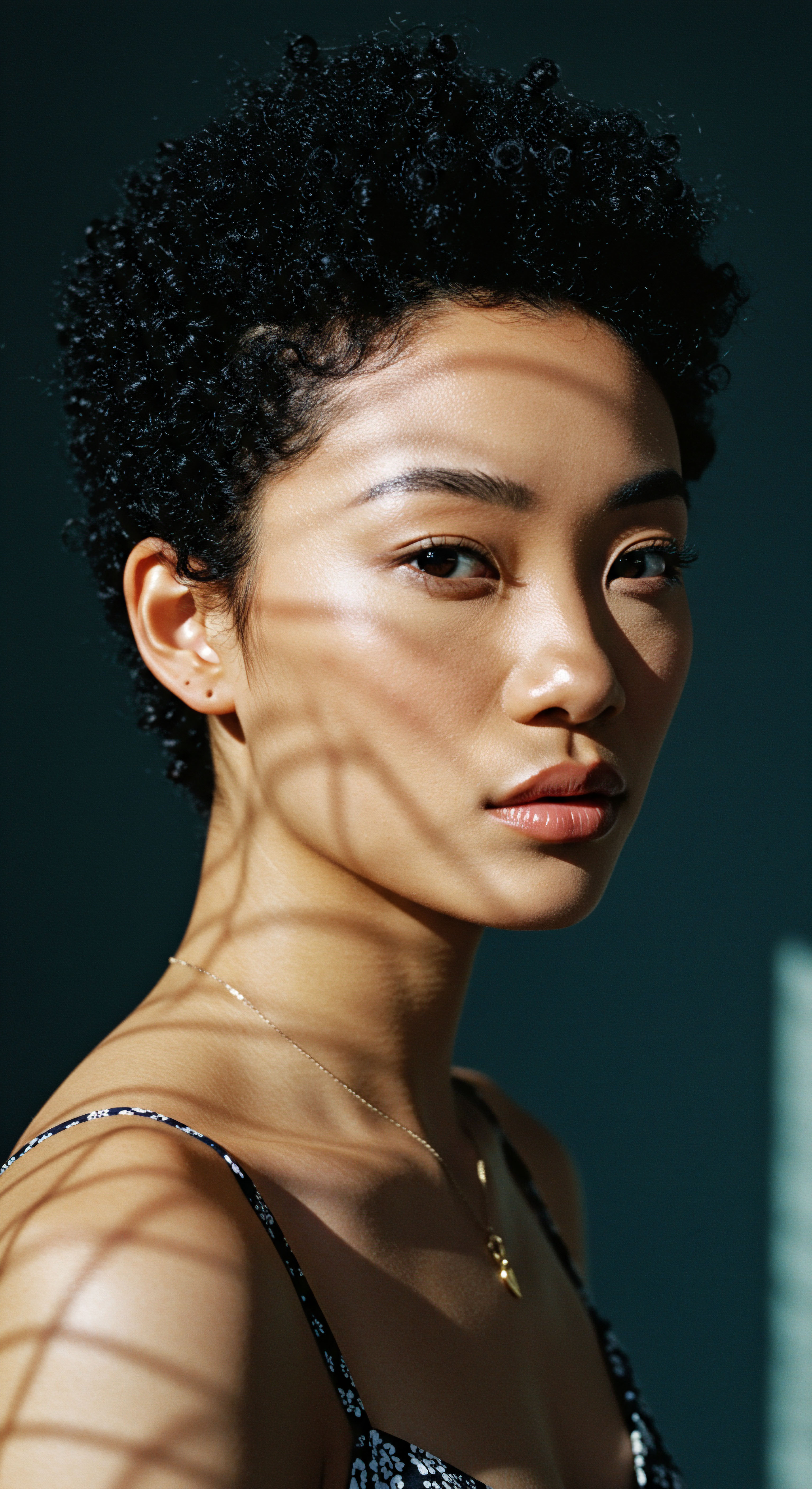
Roots
From the quiet rustle of leaves to the rhythmic sway of ancient dances, humanity has long sought connection with the natural world, often finding solace and strength in the simplest of gestures. Consider, for a moment, the age-old practice of tending to one’s scalp, a tradition spanning continents and generations. This seemingly unassuming act, whether a gentle finger dance or the measured sweep of a specialized tool, carries within it a whispered promise of vitality, a yearning for thriving strands.
This enduring human inclination, often passed down through familial lines or cultural wisdom, is not merely a comforting ritual; it rests upon a complex biological foundation, a hidden symphony of cellular responses orchestrated beneath the surface. To truly appreciate the perceived benefits of regular scalp stimulation for hair growth, we must first journey inward, past the visible crown, to the very bedrock of our hair’s existence ❉ the intricate cellular landscape of the scalp.
The hair itself, a marvel of biological engineering, begins its life deep within the dermis, nestled within structures known as hair follicles. Each follicle operates as a miniature organ, undergoing cyclical phases of growth, regression, and rest. Understanding these fundamental phases is paramount to comprehending how external forces, such as stimulation, might influence their delicate balance. At the base of each follicle lies the Dermal Papilla, a small, cone-shaped cluster of specialized mesenchymal cells.
These cells are the orchestrators, the silent conductors of the hair growth cycle, communicating with the surrounding epithelial cells that form the hair shaft. Their health and activity are directly linked to the hair’s vibrancy and density.
Beneath the visible skin, a vast network of blood vessels delivers life-sustaining oxygen and nutrients to every cell. The scalp, being a highly vascularized area, relies heavily on this intricate microcirculation to nourish its follicular inhabitants. When this delicate delivery system is compromised, or when the cellular environment lacks optimal conditions, the hair growth cycle can falter, leading to thinning or shedding. Thus, any intervention that can enhance this fundamental supply chain holds the potential to influence hair health at its most basic, cellular level.

The Hair Follicle as a Living Micro-Organ
The hair follicle, a dynamic mini-organ, cycles through distinct stages. The Anagen Phase, or growth phase, is when hair actively lengthens, driven by rapid cellular division within the hair bulb. This phase can last anywhere from two to seven years, varying significantly among individuals and hair types. Following this active period, the follicle enters the Catagen Phase, a brief transitional period lasting only a few weeks, during which growth ceases and the follicle begins to shrink.
Finally, the Telogen Phase, a resting period of a few months, precedes the shedding of the old hair and the eventual initiation of a new anagen phase. A healthy scalp maintains a high percentage of follicles in the anagen phase, ensuring consistent hair coverage and density. Disruptions to this delicate rhythm, often triggered by stress, nutritional deficiencies, or hormonal shifts, can lead to a premature entry into the resting or shedding phases, resulting in noticeable hair loss.
Within the hair follicle, a fascinating interplay of cell types and signaling pathways directs the growth process. Keratinocytes, the primary cells that produce the hair shaft, proliferate vigorously in the hair matrix. Their division and differentiation are precisely controlled by signals from the dermal papilla cells.
These papilla cells, in turn, are influenced by their surrounding environment, including mechanical cues and the availability of growth factors. The health of these cells and their communication networks are fundamental to the perceived benefits of external stimuli.
The hair follicle operates as a miniature, self-renewing organ, its vitality governed by a complex interplay of cellular signals and environmental factors.

Cellular Constituents of Hair Growth
To truly appreciate the impact of scalp stimulation, one must recognize the key cellular players involved in hair growth.
- Dermal Papilla Cells ❉ These specialized mesenchymal cells, nestled at the base of the hair follicle, are central to regulating hair growth and cycling. They communicate with the epithelial cells of the hair matrix, dictating the hair’s size, shape, and growth duration.
- Hair Follicle Stem Cells ❉ Located in a region called the bulge, these quiescent stem cells are responsible for regenerating the hair follicle during each new cycle. Their activation is a critical step in initiating new hair growth.
- Keratinocytes ❉ These cells form the bulk of the hair shaft and are responsible for producing keratin, the protein that gives hair its strength and structure. They undergo rapid proliferation during the anagen phase.
- Sebaceous Glands ❉ Adjacent to the hair follicle, these glands produce sebum, a natural oil that lubricates and protects the hair and scalp. While not directly involved in hair growth, their healthy function contributes to a supportive scalp environment.
| Cell Type Dermal Papilla Cells |
| Primary Function Regulate hair cycle, signal hair matrix cells |
| Relevance to Scalp Stimulation Directly influenced by mechanical stretch and improved nutrient delivery |
| Cell Type Hair Follicle Stem Cells |
| Primary Function Regenerate hair follicle, initiate new growth |
| Relevance to Scalp Stimulation Potential activation through improved microenvironment and signaling |
| Cell Type Keratinocytes |
| Primary Function Produce hair shaft, rapid proliferation |
| Relevance to Scalp Stimulation Benefit from enhanced nutrient supply and growth factors |
| Cell Type Endothelial Cells |
| Primary Function Form blood vessels, regulate blood flow |
| Relevance to Scalp Stimulation Crucial for increased microcirculation during stimulation |
The initial understanding of scalp stimulation often centers on its capacity to enhance blood flow, a straightforward yet impactful mechanism. Increased blood flow means a more robust delivery of oxygen, essential nutrients, and growth factors to the hungry hair follicles. This improved circulation creates an optimal environment for the dermal papilla cells and surrounding structures to perform their functions more effectively, laying the groundwork for stronger, more resilient hair. This foundational understanding sets the stage for exploring the deeper, more subtle cellular dialogues that scalp stimulation initiates.

Ritual
Consider the comforting touch, the mindful practice of caring for oneself. The rhythmic movement of fingers across the scalp, or the gentle glide of a brush, transcends mere sensation; it becomes a deliberate act of tending, a personal ritual. For many, this practice is a cherished moment of self-care, a quiet affirmation of connection to one’s own body.
Yet, beneath this tranquil surface, a fascinating series of biological events begins to unfold, transforming a simple gesture into a complex cellular dialogue. The perceived benefits of regular scalp stimulation for hair growth extend beyond anecdotal comfort, delving into measurable physiological responses that lay the groundwork for a more vibrant scalp ecosystem.
When the scalp receives regular, consistent stimulation, whether through manual massage or the use of specialized tools, it initiates a cascade of cellular and physiological responses. The most immediate and widely recognized effect is an increase in local blood circulation. The mechanical pressure and friction exerted during stimulation act as a localized vasodilator, widening the tiny blood vessels (capillaries) that supply the hair follicles. This enhanced blood flow means a more efficient transport system for vital resources.

The Role of Microcirculation
The scalp’s microvasculature plays a central part in hair health. Each hair follicle requires a steady supply of oxygen, glucose, amino acids, and vitamins to sustain its high metabolic activity, particularly during the active anagen phase. Scalp stimulation helps ensure this supply.
Think of it as tending to a garden ❉ consistent watering and nutrient delivery are paramount for plant growth. Similarly, consistent blood flow provides the essential “nutrients” for hair follicles to thrive.
Beyond nutrient delivery, improved microcirculation also aids in the removal of metabolic waste products from the follicular environment. Just as a healthy ecosystem requires efficient waste disposal, so too does a healthy scalp. The accumulation of cellular debris or inflammatory byproducts can hinder follicular function. By facilitating lymphatic drainage and venous return, scalp stimulation contributes to a cleaner, more conducive environment for hair growth.
Consistent scalp stimulation acts as a conductor for the scalp’s microvascular orchestra, enhancing the delivery of life-sustaining nutrients and the removal of cellular byproducts.

Mechanical Signals and Cellular Response
The benefits of scalp stimulation are not solely attributed to improved blood flow. The mechanical forces themselves—the stretching, compression, and shear stress applied to the scalp tissues—are potent signals that cells can interpret. This phenomenon, known as Mechanotransduction, refers to the process by which cells convert mechanical stimuli into biochemical signals.
Within the scalp, various cell types, including fibroblasts, endothelial cells, and crucially, the dermal papilla cells, possess mechanoreceptors. These specialized proteins sense changes in their physical environment. When stretched or compressed, these receptors trigger intracellular signaling pathways.
For instance, the application of mechanical stress can lead to the activation of specific ion channels, the release of intracellular calcium, and the rearrangement of the cell’s cytoskeleton. These initial biochemical events can then translate into changes in gene expression, protein synthesis, and ultimately, cellular behavior.
For hair follicles, this means that the mechanical forces of scalp stimulation can directly influence the activity of dermal papilla cells. These cells, upon receiving mechanical cues, may increase their production of various Growth Factors and signaling molecules that are known to promote hair follicle proliferation and survival. These growth factors then act on the surrounding keratinocytes and hair follicle stem cells, encouraging them to remain in or transition into the active growth phase.
A significant study by Koyama et al. (2016) explored this very concept, revealing compelling evidence. In their research, nine healthy men received four minutes of standardized scalp massage daily for 24 weeks. The results showed a measurable increase in hair thickness, indicating a positive impact on hair growth.
What was particularly compelling was their finding that these stretching forces resulted in significant changes in gene expression within human dermal papilla cells, both in vitro and in vivo. Specifically, they observed an upregulation of hair cycle-related genes such as NOGGIN, BMP4, SMAD4, and IL6ST, alongside a downregulation of hair loss-related genes like IL6. This direct evidence of gene expression alteration provides a profound insight into how mechanical stimulation translates into biological changes at the cellular level.

Can Scalp Massage Influence Follicle Size?
While hair density (the number of hairs per square centimeter) may not always show dramatic changes with scalp stimulation, the thickness of individual hair strands often does. This observation, supported by studies like Koyama et al. (2016), suggests that the mechanical stimulation influences the dermal papilla cells to produce a more robust hair shaft.
A thicker hair strand contributes significantly to the overall perceived fullness and health of the hair. This indicates a shift in the quality of hair production, rather than simply an increase in the number of active follicles.
The ritual of scalp stimulation, therefore, is not merely a pleasant sensation. It is a nuanced interaction with the scalp’s biology, a gentle persuasion of its cellular machinery to perform optimally. By enhancing circulation and directly influencing cellular behavior through mechanotransduction, these regular practices contribute to a healthier environment where hair can truly flourish, not just survive.

Relay
To truly comprehend the depth of regular scalp stimulation’s influence on hair growth, we must move beyond the surface-level observations and journey into the intricate cellular relay race occurring within the scalp. This exploration reveals a sophisticated biological dialogue, where mechanical forces trigger a cascade of molecular events, influencing not only the hair follicle itself but also its surrounding microenvironment and the broader physiological landscape. This advanced perspective requires us to consider the interplay of mechanobiology, inflammatory responses, and even the activation of dormant cellular reserves.
The mechanical stress applied during scalp stimulation—the stretching, compression, and slight friction—is not simply a physical force; it acts as a powerful biological signal. Cells within the scalp, particularly the dermal papilla cells (DPCs) and fibroblasts, are exquisitely sensitive to these mechanical cues. They possess specialized structures, including the cytoskeleton and focal adhesions, which connect the cell’s internal machinery to its external environment. When these structures experience mechanical strain, they initiate a process known as Mechanosignaling, translating the physical force into biochemical messages.

The Wnt/β-Catenin Pathway and Hair Cycle Modulation
One of the most critical pathways influenced by mechanical stimulation is the Wnt/β-Catenin Signaling Pathway. This pathway is a master regulator of hair follicle development and cycling. Wnt proteins are a family of secreted signaling molecules that play crucial roles in cell proliferation, differentiation, and tissue regeneration. When Wnt signaling is activated, it leads to the accumulation of β-catenin in the cell’s cytoplasm, which then translocates to the nucleus, where it binds to transcription factors and initiates the expression of genes involved in hair growth.
Research indicates that mechanical stretching can trigger the nuclear localization of β-catenin, thereby activating the Wnt signaling pathway within epidermal cells and dermal papilla cells. This activation is a powerful stimulus for hair follicle stem cells and progenitor cells, encouraging them to enter and maintain the anagen (growth) phase. This direct cellular communication mechanism explains how the physical act of scalp stimulation can translate into prolonged hair growth and potentially even the activation of quiescent follicles.

Growth Factor Orchestration
Beyond Wnt signaling, scalp stimulation appears to orchestrate the release and expression of various growth factors, essential biochemical messengers that regulate cell growth, survival, and differentiation.
- Vascular Endothelial Growth Factor (VEGF) ❉ While improved blood flow is a direct benefit, mechanical stimulation can also induce the production of VEGF, a potent angiogenic factor. VEGF promotes the formation of new blood vessels and enhances the existing vascular network around hair follicles, further improving nutrient and oxygen supply. This creates a positive feedback loop, where mechanical stimulation leads to better blood flow, which then supports the production of more VEGF, reinforcing the improved microcirculation.
- Insulin-Like Growth Factor 1 (IGF-1) and Hepatocyte Growth Factor (HGF) ❉ Studies suggest that mechanical stretch can induce the alternative activation of macrophages within the skin. These activated macrophages, specifically M2 macrophages, are known to secrete growth factors such as IGF-1 and HGF. Both IGF-1 and HGF are powerful stimulants for hair follicle stem cells and dermal papilla cells, promoting their proliferation and differentiation, which are critical for hair regeneration. This less commonly discussed pathway highlights a sophisticated immune-mediated response to mechanical stimuli.
This complex interplay of mechanical and chemical signals creates a highly conducive environment for hair growth. The very act of applying pressure and movement to the scalp initiates a cascade of events that speaks directly to the cells responsible for hair vitality.

Modulating the Inflammatory Landscape
Chronic low-grade inflammation in the scalp is often implicated in various forms of hair loss, including androgenetic alopecia and other inflammatory alopecias. Scalp stimulation may play a role in modulating this inflammatory environment. While intense, damaging friction could exacerbate inflammation, gentle, regular stimulation may help to reduce pro-inflammatory cytokines (like IL-6, which was downregulated in the Koyama study) and potentially increase anti-inflammatory mediators.
The mechanical forces can influence the behavior of immune cells present in the scalp, guiding them towards a more pro-regenerative phenotype. This delicate balancing act, where stimulation helps to quell inflammatory signals that might otherwise impede hair growth, is a nuanced aspect of its perceived benefits.
The scalp’s response to stimulation extends beyond simple circulation, involving complex mechanosignaling pathways that activate growth factors and modulate inflammatory processes.

Addressing Scalp Fibrosis and Stiffness
A less commonly discussed but highly relevant mechanism involves the impact of scalp stimulation on tissue stiffness and fibrosis. Conditions like androgenetic alopecia are often associated with increased perifollicular fibrosis—the accumulation of collagen around hair follicles, which can restrict their ability to grow and miniaturize. Scalp stiffness, potentially linked to chronic muscle tension or underlying fibrotic processes, may also impede optimal blood flow and mechanical signaling to the follicles.
Regular scalp massage, through its mechanical action, could potentially help to break down or prevent the excessive formation of this fibrotic tissue, making the scalp more pliable. A more elastic scalp environment might allow hair follicles greater freedom to cycle and grow, reducing the physical constraints that contribute to miniaturization. While more direct research is needed to definitively link scalp massage to the reversal of established fibrosis, the theoretical basis for its ameliorating effect on tissue stiffness is compelling. The ability of mechanical forces to remodel extracellular matrix components is well-established in other tissues, suggesting a similar potential within the scalp.
| Mechanism Enhanced Microcirculation |
| Cellular Impact Increased oxygen, nutrient delivery to DPCs and keratinocytes; waste removal |
| Hair Growth Outcome Improved follicular health, sustained anagen phase |
| Mechanism Mechanotransduction |
| Cellular Impact Activation of mechanoreceptors on DPCs and fibroblasts |
| Hair Growth Outcome Initiation of Wnt/β-catenin signaling, gene expression changes |
| Mechanism Growth Factor Production |
| Cellular Impact Increased VEGF, IGF-1, HGF from DPCs, macrophages |
| Hair Growth Outcome Stimulated hair follicle stem cells, prolonged anagen, angiogenesis |
| Mechanism Inflammation Modulation |
| Cellular Impact Reduction of pro-inflammatory cytokines (e.g. IL-6) |
| Hair Growth Outcome Reduced follicular damage, healthier scalp environment |
| Mechanism Tissue Remodeling |
| Cellular Impact Potential reduction of perifollicular fibrosis and scalp stiffness |
| Hair Growth Outcome Less physical restriction on follicles, improved growth potential |
| Mechanism These mechanisms collectively contribute to the perceived benefits of scalp stimulation. |

What Does Mechanobiology Reveal About Hair Growth?
Mechanobiology, the study of how physical forces influence biological processes, offers a profound lens through which to view scalp stimulation. It moves beyond the simplistic notion of “more blood flow” to acknowledge that cells are not passive recipients of biochemical signals; they are active participants, constantly sensing and responding to their physical surroundings. The scalp, as a dynamic tissue, is under constant mechanical tension, and changes in this tension can significantly impact cellular behavior. The mechanical stimulation from massage essentially provides a form of controlled, beneficial stress that cells are equipped to interpret and respond to in a pro-growth manner.
The cumulative effect of these cellular relays is a more robust, healthier hair growth cycle. From the enhanced delivery of essential nutrients to the intricate dance of mechanosignaling and growth factor release, regular scalp stimulation sets in motion a sophisticated biological program. This program works to optimize the conditions for hair follicles to thrive, leading to the noticeable improvements in hair thickness, vitality, and overall scalp health that many individuals experience. The ritual, when understood through this scientific lens, transforms into a deliberate act of cellular encouragement, a profound connection between external touch and internal biological harmony.

Reflection
As we gently pull back from the intricate world of cellular mechanisms, a broader perspective emerges. The journey into the microscopic realm of hair follicles and signaling pathways reveals a profound truth ❉ the practices we adopt, the quiet moments of care, are not merely superficial gestures. They resonate deeply within our biological architecture, initiating a silent, powerful dialogue at the cellular level. This understanding lends a new reverence to the act of tending to one’s scalp, transforming it from a simple routine into a meaningful conversation with the very essence of our hair’s vitality.
The wisdom of ancestral practices, often dismissed as mere tradition, finds its echo in modern scientific discovery. The rhythmic motions of a scalp massage, a legacy passed down through generations, are now seen as a sophisticated form of mechanotherapy, influencing gene expression and fostering a pro-growth environment. This convergence of ancient wisdom and contemporary science invites us to reconsider our relationship with our hair, viewing it not just as an aesthetic adornment but as a dynamic, responsive living system.
In this continuous exploration, the textured hair community holds a unique position. For us, hair care has always been more than a routine; it is a celebration of heritage, a declaration of identity, and a profound act of self-acceptance. The insights gained from understanding the cellular underpinnings of scalp stimulation deepen this connection, providing a scientific affirmation for practices that have long been intuitively understood. It is a reminder that the perceived benefits are not imagined, but rather a testament to the intricate and beautiful resilience of our strands, awaiting our gentle encouragement to truly flourish.

References
- Koyama, T. & Kobayashi, K. (2016). Standardized Scalp Massage Results in Increased Hair Thickness by Inducing Stretching Forces to Dermal Papilla Cells in the Subcutaneous Tissue. ePlasty, 16, e8.
- Kishimoto, J. Burgeson, R. E. & Morgan, B. A. (2000). Wnt signaling maintains the hair-inducing activity of the dermal papilla. Genes & Development, 14(10), 1181-1185.
- Chu, S. Y. Chou, Y. L. Huang, Y. H. & Yang, S. C. (2019). Mechanical stretch induces hair regeneration through the alternative activation of macrophages. Cell Reports, 27(1), 101-113.e5.
- Guo, S. Zhang, S. & Li, C. (2022). Hair follicle stem cells promote epidermal regeneration under expanded condition. Frontiers in Cell and Developmental Biology, 12, 1373500.
- Kishimoto, J. Yang, J. S. & Morgan, B. A. (2002). Wnt/beta-catenin signaling in hair follicle development. Developmental Cell, 2(5), 643-653.
- Khoury, J. K. & Khumalo, N. P. (2019). Reliability of Histopathology for the Early Recognition of Fibrosis in Traction Alopecia ❉ Correlation with Clinical Severity. Dermatopathology, 6(4), 170-181.
- Lee, Y. J. Kim, M. J. Kim, D. Y. Lee, Y. W. & Kim, H. Y. (2021). Micro-Current Stimulation Has Potential Effects of Hair Growth-Promotion on Human Hair Follicle-Derived Papilla Cells and Animal Model. International Journal of Molecular Sciences, 22(8), 4153.
- Khumalo, N. P. Ngwanya, R. M. & Adeola, H. A. (2019). Traction Alopecia ❉ A Clinical and Histopathological Study. Clinical and Experimental Dermatology, 44(2), 143-149.
- Paus, R. & Cotsarelis, G. (2008). The biology of hair follicles. New England Journal of Medicine, 359(12), 1262-1273.
- Kwon, O. S. Pyo, H. K. & Park, K. C. (2007). Effect of topical minoxidil on hair growth in male pattern baldness ❉ A randomized, placebo-controlled, double-blind trial. Journal of the American Academy of Dermatology, 57(5), 779-786.